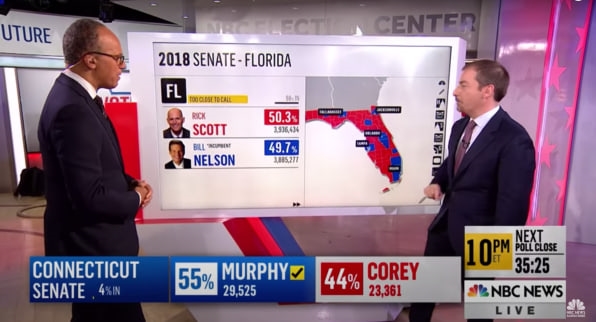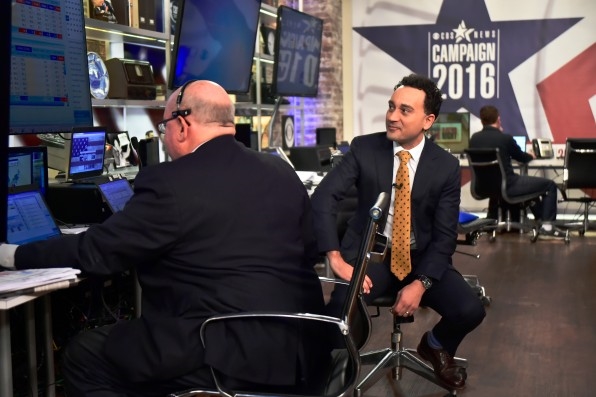How the media is preparing for an election night that could go on for weeks
Everyone has their own election night ritual. It may be tuning into MSNBC to see Steve Kornacki compute electoral math and navigate complex interactive screens, or watching CNN’s array of pundits yell at each other from across the studio. It may be watching anxiously as virtual maps fill up in blue and red, or constantly refreshing The New York Times home page to see the fateful needle sway back and forth. Some may plan election parties with themed food from swing states. Wiser folks may deliberately sleep through it and ignore the media frenzy altogether.
Whatever your election night plans, expect it to change this year—because it’s very likely we won’t know who’ll be the next president on November 3. The pandemic has suddenly ushered in an era of massively increased mail-in voting, which threatens to create delays due to laborious counting processes and lack of experience. Certain patterns and clues that the media usually uses calling state races may not apply. These media outlets, and state officials, will have an added responsibility to keep the public continually abreast of decisions as votes slowly amble in, such as in the case of several of this cycle’s congressional primary races in New York, which took almost two weeks to call. That ongoing communication will serve to ensure that false messages of fraud and fixing from the White House are debunked.
“Our advice to people at outlets is to not expect it to be like it has been in the past,” says Drew McCoy, president of Decision Desk HQ. “There are just too many new variables.”
Why the mail-in process takes so long
Decision Desk HQ is one of the three major election-reporting firms, which collect vote counts from every locality in the country. That means thousands of places, because the U.S. has a decentralized election system, where each state has a different reporting method. In Georgia, the state usually reports all the results. In Wisconsin, it’s up to individual counties; in Florida, it’s a bit of both. In Massachusetts, these firms have to ask each individual township for the data.
To add to the complexity, 2020 is no normal year. In the past months, driven by fears of COVID-19 infection at polling sites, and live demonstrations of voting calamities such as the Wisconsin primary— where voters were forced to risk their health by visiting the polls in person—states have been preparing for mail-in voting, injecting funds into systems to create robust absentee ballot processing centers. (The Senate has still not approved the updated $3.6 billion recommended by the House for this purpose.) While each state has a completely different setup with respect to ballot request and return deadlines, security checks, and ID requirements, counting absentee ballots universally takes longer than in-person votes.
Washington is one of seven states that conducts mail-only voting; just 1% to 2% of the population votes in person, says Kim Wyman, the secretary of state. She describes the protracted process that occurs once officials receive ballots, even in a state with a sturdy system. They check signatures, check voters off the roll to ensure there are no duplicates, open the ballot’s multiple envelopes and verify the security sleeves, which anonymize a person’s vote, and ensure it’s filled out correctly for machine reading.
In Washington, state law allows them to start this “processing” 10 days before November 3, but 16 states have decided they will not start processing so until Election Day or the day before (Maryland will not start until the day after). “Those states are going to get swamped with absentee ballots,” Wyman says, “and it’s going to take them weeks to just process them, verify them, and get ready for counting.”
Because the law says that ballots postmarked by Election Day are valid, about 60% of the ballots in Washington don’t even typically arrive until Election Day. And then, 11 states allow for ballot “curing,” or correcting, if there’s a problem; in most states, that requires voters to send a form back to administrators with a signature. In Washington, this can be done up to 21 days after Election Day. Throughout this process, there are USPS delays (which seem to be a worsening problem) to factor in.
Washington has the advantage of being well-rehearsed in absentee voting. For other states, one of the most contentious presidential races in modern years will also be their absentee-voting test run. “Our state has had a decade to build in the processes, procedures, and the equipment and facilities to be really efficient,” Wyman says. “And these other states are having to do this in a matter of months.”
Even for some of the more seasoned states, the expanded volume of incoming ballots will be challenging. Many states have offered mail-in voting as an option in the past, but the scaling-up this year is considerable: Michigan expects 71% of its votes will happen by mail, up from 25% in 2016; Hawaii thinks it will be 91%, up from 39%. New Jersey is planning on a 70%, up from 7%.
“I don’t think we’re going to know who the president is on election night,” Wyman says. “I’m very confident of that. And we will probably not know until the middle or the end of November.”

No longer reliable rhythms and rules of thumb
After they’ve collected the voting data, the three major election-calling firms issue it to the media outlets they work with. For Decision Desk HQ, those are online publications including BuzzFeed and Vox; for the Associated Press, it includes Fox News; and for Edison Research, it’s CNN, NBC, CBS, and ABC. It’s then down to the networks’ own decision desks to decide when to call race winners.
The media outlets have come to develop certain “rhythms” over the years as they analyze voting data, which instructs how they can often make projections even without many votes reported. Kyle Kondik, managing editor of Sabato’s Crystal Ball, an elections newsletter run by the Center for Politics at the University of Virginia, gives the example from that state, where many of the rural Republican areas tend to be reported before the Democratic Fairfax County, which then turns the state blue.
But, because of the new prevalence of absentee voting, these rhythms may not play out in the same way. “You have these rules of thumb you look at,” says Decision Desk HQ’s McCoy. “A lot of that has been washed away.” With mail-in voting, the preexisting trends that decision desks expect, defined by factors like demographics, geography, and community type, may no longer be illuminating if votes are flooding in from more central absentee ballot processing centers.
Even without the traditional clues, it may still be possible to call some states without total votes counted. “If somebody’s winning the race by 20 points, and you think you have three-quarters of the vote, you can kind of do the back-of-the-envelope math yourself,” says John Lapinski, the director of the Election Unit at NBC News. Kondik says you can also look at results from one state as a guide for a similar state. “If Biden wins Ohio”—a Rust Belt state that’s forecasted to be the hardest for Democrats—”the election is over,” he says.
Reliably partisan states, like California and New York, are likely to be called on election night, McCoy predicts, even despite their large populations and heaps of absentee ballots. Which states we see shaded in on electoral college maps will probably hinge a lot on the partisan nature of those states, as well as their experience with mail-in voting. If it’s a tight election, swing states that are voting by mail will be tough to call. “There is a map you could build that would get one or the other candidate to 270 electoral votes on election night,” McCoy says. “Do most people think that’s likely? No.”
Even in a “blowout,” McCoy doesn’t think we’ll see a winner emerge on the night. McCoy and Kondik both point to Pennsylvania’s primary in June, when Republicans had originally appeared to outpace Democrats, before Philadelphia’s votes came in days later, helped rack up 440,000 more votes in the state for Democrats than Republicans. Of course, this was a non-competitive race, just a matter of formality, but it provides a sense of how the state may play out in November.
And, if it were to repeat, it would be irresponsible for networks to call the race for Biden, even if they knew those Philadelphia votes were expected. They have to make careful decisions, based on the data and exit polls that are in. That’s particularly vital in a year when the president tweets on an almost-daily basis about mail-in voter fraud, and is asserting months before Election Day that results will be inaccurate.

The need for transparency if Trump cries fraud
It’s not nefarious when a state suddenly “flips” to the other party, as in the case of Pennsylvania. Outlets are simply reporting how people have voted, but they have little control over the order in which the results come in. If and when that does happen in November: “I think we could guess with reasonable certainty that [Trump] will probably be screaming that it is fraudulent,” Kondik says. “It would be extremely out of character for him to not behave that way.”
That creates high stakes for networks to be scrupulously accurate before calling races. “The public really needs to be spoon-fed on this, because it is going to be different than what we’re used to,” Kondik says, warning that political actors, including the president, will likely be putting out deceptive information. “If they’re gonna call something,” he says of the networks, “they’re going to have to be damn sure that they’re right.”
Retractions are not uncommon; in the 2018 race for California’s 21st Congressional District, conducted largely by mail, both Decision Desk HQ and the AP called the race for Republicans before reversing it as mail votes trickled in over two weeks and gradually “flipped” the district blue. Decision Desk HQ also retracted a premature call in Tuesday’s contested primary for Missouri’s 1st Congressional District, when progressive Cori Bush emerged victorious only later in the night.
Accuracy is always a priority, and comes before any competitive pressures, says Anthony Salvanto, director of Elections and Surveys at CBS News. Salvanto says his network will begin priming audiences on the reality of delays from now. “I want to reinforce that idea for the audience in advance of election night, because this will properly set expectations.” NBC News’ Lapinski agrees: “We’re educating the public to make sure that people understand that it could take longer.” That on-air transparency will continue for days and weeks, both say, during which presenters will explain why certain calls are made or not made.
In terms of better practice, Kondik suggests eliminating the popular “precincts reported” metric because it doesn’t factor in mail-in ballots, and leads to surprises when votes are still emerging after an apparent 100% of precinct data is in. He recommends using the percentage of 2016 turnout as an alternative gauge. In Pennsylvania, for instance, presidential election turnout has remained between 5.8 million and 6.1 million between 2004 and 2016, so it could make for a rough but relatively intuitive guide.
But, there’s also the conflicting pressure of speed. Trump has also tweeted that we “must know” the result on election night, and so the longer we have no result, the more chance there is that he’ll cry fraud. McCoy says his firm won’t be bowing to that pressure and is ready for a data-collecting marathon. “We’re probably going to be in election-night mode everyday for an unknown period of time,” he says. (There is no law that says we must know the result on election night.)
Washington’s Wyman agrees that accuracy takes priority over speed, since the consequences of calling an election of this scale on the night because of pressure from the top is too risky. And the public needs to be educated that a drawn-out process is a sign not of election fraud but of due diligence to prevent fraud. Her main message, for political authorities, for networks, and for the public, is: Be patient.
“The hard part for election officials is reminding people that slow doesn’t mean anything’s going wrong or is bad,” she says. “It means that the process is working the way it’s supposed to.”
(27)



